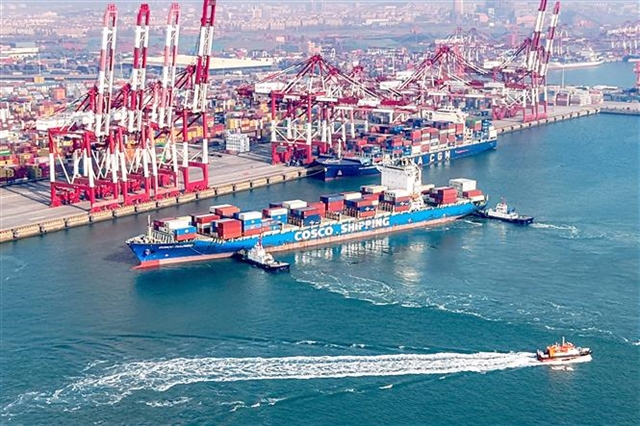China-Việt Nam economic ties have thrived, with bilateral trade reaching US$260.65 billion in 2024, a 13.5 per cent increase, and Việt Nam becoming a key destination for Chinese investors.

BEIJING — Economic and trade ties between Việt Nam and China have soared to new heights in recent years, with bilateral trade turnover topping US$260 billion in 2024, according to comnews.cn, a commercial news website of China’s Ministry of Commerce.
Data from China’s General Administration of Customs revealed that this country remains Việt Nam's largest trade partner for over 20 years while the General Department of Vietnam Customs estimated that bilateral trade accounted for nearly a third of Việt Nam's total trade in 2024.
Bilateral economic and trade ties hit key milestones
Comnews.cn reports that China - Việt Nam's economic ties have flourished, with bilateral trade and investment growing rapidly.
In 2024, trade reached $260.65 billion, up 13.5 per cent from the previous year. That consists of $161.9 billion in China's exports and $98.8 billion in its imports, respectively up 17.7 and 7.2 per cent year on year. China exports mainly machinery, textiles, and raw materials to Việt Nam while importing agricultural products and minerals from the latter.
China is also Việt Nam’s top agricultural export market. From January to November 2024, Việt Nam shipped $4.1 billion worth of fruits and vegetables to China, along with $1.4 billion of aquatic products to China, respectively rising 28.7 and 23.2 per cent compared to the same period of 2023, the writing cited statistics from Vietnam Customs.
Vietnamese durian is among favourite fruits of Chinese consumers. Since getting license in 2022, fresh durian exports to China have increased considerably, with 692,500 tonnes valued at $2.7 billion in the first 10 months of 2024.
In terms of investment cooperation, Việt Nam is an important destination for Chinese investors, who poured $1.97 billion into the Southeast Asian country during January - August 2024, the article noted.
Việt Nam’s statistics show that China’s direct investment in Việt Nam reached $4.47 billion in 2023, with the total figure standing at $27.82 billion by the end of the year. In recent years, the Hanoi Metro Line No. 2, built by Chinese companies, has improved local transportation. Chinese firms have also invested in some solar and wind energy projects, setting an example of green economic cooperation.
A significant development was seen in December 2024, when the two countries signed an inter-governmental agreement on a cross-border standard-gauge railway project, which includes three major railway lines: Lào Cai - Hà Nội - Hải Phòng, Lạng Sơn - Hà Nội, and Móng Cái - Hạ Long - Hải Phòng.
Great potential
Experts see vast potential for China - Việt Nam economic cooperation.
Yuan Bo, Director of the Institute of Asian Studies at the Chinese Academy of International Trade and Economic Cooperation, stated that within the frameworks of the China - ASEAN Free Trade Area and the Regional Comprehensive Economic Partnership (RCEP), both countries persist in promoting an open and free development approach to actively advance high-quality free trade cooperation.
Looking ahead, the development of the China - ASEAN Free Trade Area 3.0 and the RCEP upgrade will further step up trade and investment liberalisation and facilitation. The two countries will also reach consensus on emerging sectors such as the digital economy, green economy, and supply chain connectivity. It is expected that future improvements in soft connectivity in areas like goods, factors, markets, rules, and standards will be further enhanced in the future.
As cross-border infrastructure projects such as standard-gauge railways, cross-border economic cooperation zones, smart ports, and smart customs progress, hard connectivity will enter a new development phase, generating new opportunities for bilateral economic cooperation.
In addition to traditional trade and investment, Yuan Bo noted that China and Việt Nam also boast great potential for growth in the digital and green economies.
Việt Nam's digital economy is rapidly developing compared to other Southeast Asian nations'. Reports show that in 2024, its digital economy maintained a double-digit growth rate, with a compound annual growth rate of 16 per cent and a total goods value of $36 billion, primarily driven by e-commerce and online tourism.
In the future, Việt Nam and China could strengthen policy coordination, innovate cooperation models, and promote deeper integration of cross-border e-commerce with traditional domestic industries, Yuan said. He suggested enhanced cooperation in digital transformation, online tourism, smart city building, artificial intelligence, and other areas to further unlock the cooperation potential of the digital economy.
Meanwhile, Việt Nam places significant emphasis on the development of a green economy and has established a national green growth strategy. With the inclusion of green economy rules and cooperation initiatives in the China - ASEAN Free Trade Area 3.0, the two countries hold vast cooperation potential in clean energy, new energy vehicles, environmental governance, green finance, and more. — VNS





